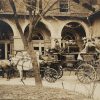calsfoundation@cals.org
Crawford Goldsby (Execution of)
aka: Cherokee Bill (Execution of)
Twenty-year-old Crawford Goldsby, usually referred to in news reports as “Cherokee Bill,” was hanged at Fort Smith (Sebastian County) on March 17, 1896, for a murder committed in the Indian Territory.
Crawford Goldsby was born on February 9, 1876, at Fort Concho, Texas, the son of a soldier in the Tenth U.S. Cavalry Regiment who was “of Mexican descent” and Ellen Beck, whose ancestry included white, Black, and Cherokee people. His parents broke up when he was young, and at age seven he moved with his mother to Fort Gibson in the Indian Territory (present-day Oklahoma). He attended the Indian School at Carlisle, Pennsylvania, until returning to Indian Territory at age twelve.
By the time he was eighteen, Goldsby was riding with the Bill Cook gang, which launched a crime spree in 1894. The Arkansas Gazette reported that “stores were looted, travelers were held up on the highway, express offices were robbed…horses were stolen and railroad traffic was interfered with to such an extent that express companies refused to carry money into the Territory.”
On November 8 or 9, 1894, Goldsby and another member of the gang were robbing a store at Lenepah, Indian Territory, when Goldsby saw Ernest E. Melton watching from behind a window in a nearby building and shot him in the head, killing him. He later shot his brother-in-law to death before being captured on January 29, 1895, and taken to the federal jail at Fort Smith.
He was tried for Melton’s murder in Judge Isaac Parker’s courtroom of the Western District of Arkansas on February 25, 1895, and was found guilty the following day. Parker sentenced both him and convicted murderer Webber Isaacs to hang on June 25, 1895, but the executions were delayed while their attorneys appealed the conviction to the U.S. Supreme Court.
On July 26, 1895, jailer R. C. Eoff and guard Lawrence Keating were checking the cell doors in the Fort Smith jail when they found a lock had been tampered with. As they examined the lock, Goldsby, who had somehow procured a pistol, shot Keating in the stomach, mortally wounding him. After a gun battle with federal lawmen during which no one else was injured, a fellow prisoner took the gun from Goldsby.
Goldsby was tried for Keating’s death on August 8, 1895, and convicted after the jury deliberated only thirteen minutes. Parker sentenced him to hang on September 10, with that execution also being postponed while his case was appealed to the U.S. Supreme Court. That appeal was rendered moot on January 13, 1896, when Parker was notified that the Court had upheld the conviction in the Melton case. The judge set March 17, 1896, as the day for Goldsby to die.
Goldsby’s mother and “the old ‘Aunty’ who raised him” visited him in the jail on the morning of March 17. He was scheduled to hang at 9:30 a.m., but the execution was delayed until 2:00 p.m. to allow time for his sister to get to Fort Smith from Fort Gibson. She failed to arrive, and Goldsby was escorted to the gallows.
U.S. Marshal George J. Crump said, “When he went to the scaffold, it was the finest exhibition of nerve I ever saw. There was not a tremor of fear about him. I asked him if he had anything to say and he replied, ‘Colonel, I came up on this platform to die, not to talk.’ He kissed his mother good-by and he was ready for the noose.”
As a black cap was placed over his head, Goldsby said “goodbye to all you chums down that way.” The trap door opened, and as the Gazette reported, “Bill’s neck was broken by the fall. There was no sign of a struggle, the heart ceased to beat in ten minutes and he was lowered into his coffin.” He was taken to Fort Gibson for burial.
For additional information:
Akins, Jerry. Hangin’ Times in Fort Smith: A History of Executions in Judge Parker’s Court. Little Rock: Butler Center Books, 2012.
“Died as He Lived.” Arkansas Gazette, March 18, 1896, p. 1.
Rose, Sammie, and Pat Wood. “Keepers of the ‘Gates of Hell’: A Narrative of George J. Crump, U.S. Marshal.” Boone County Historian 15 (October–December 1992): 514–519.
Steele, Phillip W. “Bad Luck Bill.” Ozark Mountaineer 34 (April–May 1986): 10.
Mark K. Christ
Little Rock Arkansas


 Cherokee Bill Article
Cherokee Bill Article 



Comments
No comments on this entry yet.